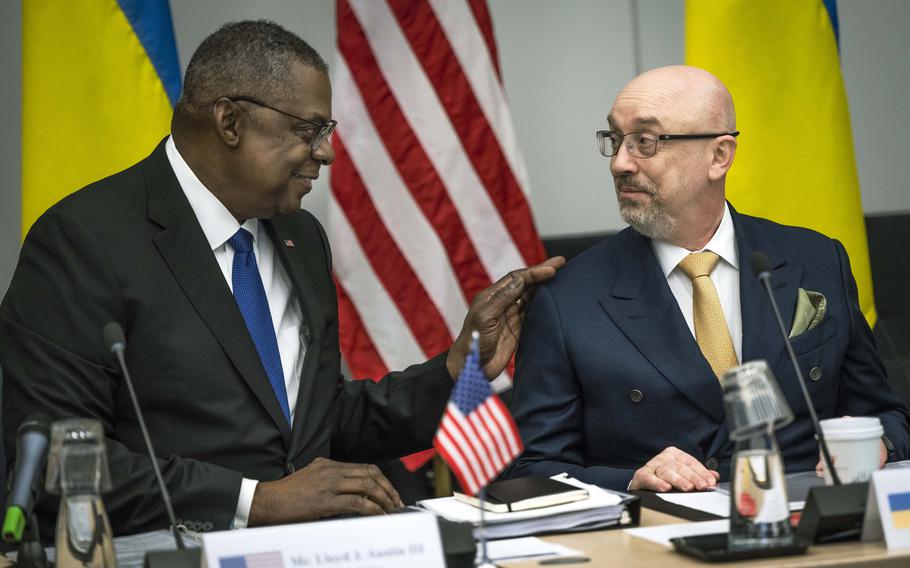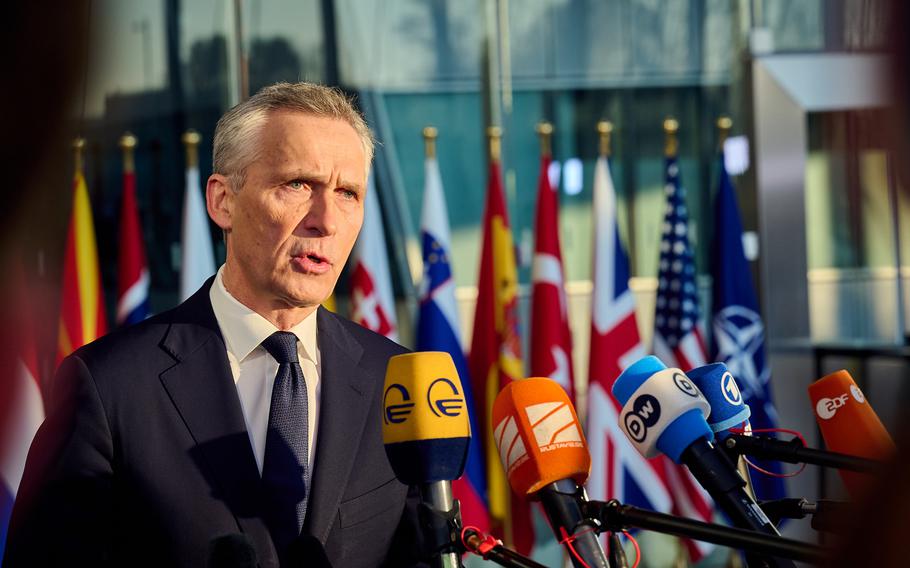
Defense Secretary Lloyd Austin greets his Ukrainian counterpart Oleksii Reznikov during the ninth Ukraine Defense Contact Group meeting at NATO headquarters in Brussels, Tuesday, Feb. 14, 2023. (Chad McNeeley/Defense Department)
The big question for NATO of whether to send F-16 fighter jets to Ukraine went unanswered Tuesday in Brussels, where Defense Secretary Lloyd Austin and other allied officials convened for high-level talks.
The latest two-day NATO gathering is centered on getting more weaponry to the front lines of the Russia-Ukraine war, which started a year ago this month.
The idea of delivering fighter jets into Ukraine has divided allies, even as Kyiv says such air power could be a game changer in the war.
During a meeting of the Ukraine Defense Contact Group, a collection of some 50 countries, most of the focus was on ensuring that weapons already sent or on their way to Ukraine have the munitions and support to keep firing.
Austin, when asked about discussions on fighter aircraft, said he didn’t have any new announcements. Instead, he said allies were trying to address Ukraine’s “most pressing needs” as the force contemplates a spring offensive in the coming weeks. Those needs include ensuring new tanks, armored fighting vehicles and other equipment arrive in time for the fight.
“It’s a monumental task to bring all those systems together, get the troops trained on those platforms and make sure we have sustainment for that,” Austin said.

NATO Secretary-General Jens Stoltenberg talks to reporters before the first day of the NATO defense ministers meeting in Brussels, Tuesday, Feb. 14, 2023. (NATO)
NATO Secretary-General Jens Stoltenberg also downplayed the question of fighter jets.
“The issue of aircraft is not the most urgent issue now, but it is an ongoing discussion,” Stoltenberg said as allies began arriving Tuesday at NATO headquarters.
Austin, flanked by Ukraine Defense Minister Oleksii Reznikov during discussions, said a focus will be getting sufficient amounts of ammunition into Ukraine.
Munition supplies have become a concern for NATO as Ukraine burns through allied stockpiles at a faster rate than industry can produce replacements. The alliance is evaluating multiple ways to ramp up production.
“We still have much more to do together, and we must intensify our focus,” Austin said.
Meanwhile, Austin said that the more advanced training on maneuver warfare now being provided to Ukrainian troops could allow them to better shape the battlefield.
That could mean ground units will require less artillery as their tactics improve, he said.
“But that’s left to be seen,” Austin said.
The meeting of the Ukraine defense group, also known as the Ramstein Group, took place in tandem with a two-day meeting of NATO defense ministers.
Stoltenberg echoed Austin’s comments, saying the top priority was ensuring that sufficient ammunition, spare parts, fuel and other supplies are flowing into Ukraine fast enough to help it contend with another anticipated Russian offensive.
“It is not all about discussing new systems … the urgent need now is to deliver the weapons that have already been promised,” said Stoltenberg, who described the upcoming phase of the war as “a battle of logistics.”
The U.S. and other NATO countries have steadily expanded the range of weaponry they are willing to deliver to Ukraine.
“Today’s meeting comes at a critical time. The Kremlin is still betting it can wait us out,” Austin said.
At the outset of the conflict, modern battle tanks were generally regarded as a no-go among allies, but now the U.S. and Germany are in the process of getting Abrams and Leopard tanks to Ukrainian troops.
Allies also have moved from simpler systems, such as Javelins and Stingers, to longer-range artillery and Patriot air defense missiles. That raises the question of whether fighter jets should be next.
Dutch Defense Minister Kajsa Ollongren said Ukraine has formally requested the F-16 from the Netherlands.
“We have to debate this with our partners and also the United States,” she said. “This is something that will take time, and it is best done behind closed doors.”
Ukraine is “very aware” that a decision will take time, Ollongren said.
Two big obstacles to a collective allied decision on whether to send fighters are the U.S. and Germany.
President Joe Biden thus far has said he is unwilling to send fighter aircraft to Ukraine. Berlin has made similar statements because it regards the provision of fighters as potentially escalatory.
But alliance members including Poland, the Baltic states and the United Kingdom have been more bullish about the idea. Britain has committed to training Ukrainian pilots in the eventuality that NATO-standard aircraft are delivered down the road.
“We know that Ukraine needs support and that also means jet fighters,” Estonia Defense Minister Hanno Pevkur said on arrival at NATO headquarters Tuesday.
Allies on Wednesday also are expected to set long-term guidelines for defense plans and discuss a new investment pledge to ensure that members are dedicating enough resources to their respective militaries.